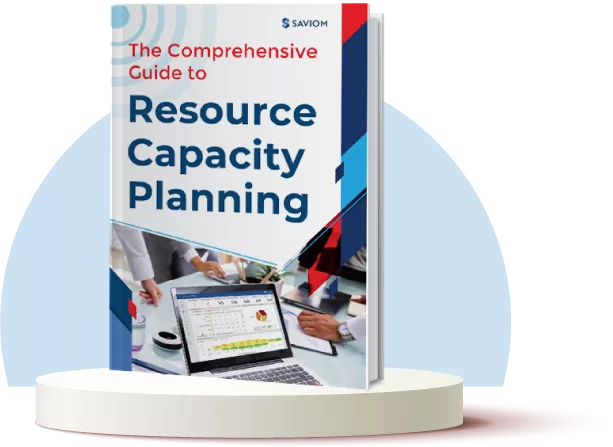Cost overrun is one of the most prevalent and disruptive challenges in project management. It can trigger a domino effect of consequences, resulting in delayed timelines, lower profit margins or bringing projects to an abrupt halt.
In many cases, project managers are compelled to compromise resource quality, scale back the project scope, or cut corners to stay within the predefined budget. This ultimately leads to stakeholder dissatisfaction, reputational damage, and missed business opportunities in the long run. That’s why project managers must implement strategic measures to identify early signs of cost overruns and minimize the risk of financial losses.
In this blog, we will look at what a cost overrun in project management means, why it happens, and how to prevent it. We will share practical, easy-to-follow tips every manager can apply for successful project delivery.
Let’s start!
What is Cost Overrun?
Cost overrun occurs when the project’s actual expense surpasses the predefined budget. A number of variables, such as employee salaries, material prices, overheads, etc., influence the project budget. Missing or miscalculating the expense of any of these variables while budgeting can lead to a financial shortfall in later stages of the project lifecycle.
Beyond estimation errors, a cost overrun can also stem from factors like scope creep, unexpected rise in material costs, equipment breakdowns, or delays caused by external dependencies. Further, if not managed promptly, cost overruns impact the organization’s ability to deliver projects within scope, budget, and timeline.
By now, we have a basic idea about it. Let’s understand cost overrun better with an example.
Cost Overrun Example
Let’s consider a construction company that takes on a contract to build a commercial office complex. The approved budget for this construction project was $1.25 million, and the duration was 12 months.
Everything goes according to plan in the beginning, but by the fourth month, several problems start to appear:
- Due to ongoing supply chain issues, the region’s steel and cement prices have risen sharply.
- At the same time, the manager discovered unexpected soil conditions at the site, which required a redesign of the foundation structure. This results in engineering delays and additional costs.
- To make matters worse, a senior project engineer resigns unexpectedly. As a result, the company rushes to hire a replacement. This added extra labor costs to the project.
In the end, the project gets delayed by three months, and the total cost increases to $1.625 million, which leads to a 30% cost overrun.
Now that we have understood what a cost overrun is, let’s move towards its causes.
Common Causes of Cost Overruns in a Firm
There are various factors that cause cost overrun risk in project management. A few of them are listed below. Let’s have a look.
Uncontrolled Scope Expansion
As per the PMI Study, “nearly 52% of projects experience scope creep, leading to an average budget overrun of 27%”.
This study highlights the effect of scope creep on the project budget. It occurs when unexpected changes arise or additional tasks are added midway, often without revisiting the timeline and budget. These ad hoc requirements affect the project workflow, extend the timeline, and demand additional resources, which, in turn, result in cost overruns.
Inaccurate Cost Estimation
As per a study by Compass International, “32% of cost overruns in construction projects occur due to underestimation of labor, material, and indirect costs.”
As the above numbers demonstrate, when managers miscalculate or overlook expenses needed to complete a project and fail to include a contingency fund, the costs can quickly spiral. As a result, the actual expenditure begins to outpace the planned budget early in the project lifecycle, putting financial strain and leading to cost overruns.
Inefficient Resource Management
Inefficient resource management is a key cause of cost overrun, especially when capacity planning is overlooked. This results in last-minute hiring or expensive contingent workers, which significantly inflates the project budget. Additionally, when a manager assigns overqualified resources to routine tasks, it leads to underutilization of skills and overspending. In short, when the right people aren’t assigned to the right tasks, both efficiency and cost control suffer, ultimately driving up the project budget.
Read More: What are Project Resources? How to Manage Them Effectively?
Low Productivity & Project Delays
Low productivity has a direct impact on the project’s timeline and profitability. When tasks take longer due to inefficiency or lack of focus, deadlines are delayed, and the overall project cycle gets disrupted. This drives up expenses related to resources and overheads, exceeding the planned budget and contributing to a cost overrun.
Absence of Risk Mitigation Strategies
Failure to identify and manage risks early in the project can lead to major cost overrun. Unexpected risks such as attrition, vendor delays, or equipment failure may catch teams off-guard. These risks can disrupt the project schedule. Further, if not predicted early, they can cause delays and unplanned expenses. Overall, a lack of mitigation planning can turn manageable risks into costly crises that can turn into cost overruns.
Lack of Change Management Framework
Without a proper change management plan, even minor variances can cause major disruption in the project. They cause scope creep, extend the project timeline, and escalate the budget. Furthermore, without a clear process to assess the impact of change on deadlines and budget, managers may underestimate the financial implications, resulting in a cost overrun.
Read More: What is Change Management in Project Management, and Why Is It Important?
Poor Communication & Collaboration
Since numerous stakeholders are involved in a project lifecycle, maintaining clear and consistent communication is crucial. However, when communication breaks down, due to unclear messaging or siloed information, expectations can become misaligned. These issues increase the likelihood of rework, duplicate efforts, and delay, which extend the project timeline and escalate the project cost.
Inflation & Market Fluctuations
Rising inflation and market fluctuations impact the cost of materials, labor, and equipment prices. This price variation can negatively affect the project budget. Moreover, inflation reduces the value of money, further escalating project expenses. In addition, if market volatility is ignored during budgeting, spending can become greater than the projected budget. These factors altogether can send the project budget off track.
Vendor & Supply Chain Disruptions
Vendors and supply chains play a crucial role in ensuring timely and cost-effective project delivery. Disruptions such as delayed deliveries, material shortages, or supplier failures often force firms to make costly adjustments. This may include expedited shipping, purchasing from higher-priced suppliers, or stocking excess inventory, which increases delivery and storage costs, leading to a cost overrun.
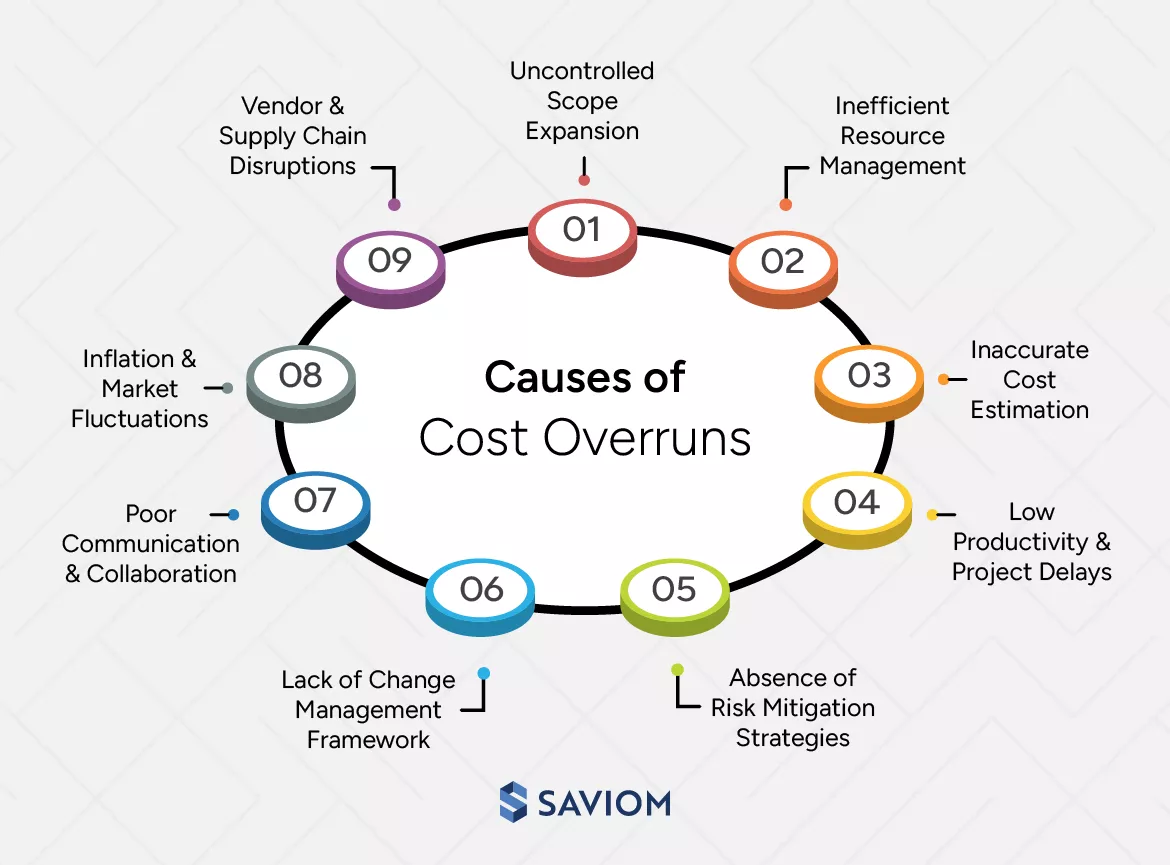
Now that we have explored the causes of cost overrun, let’s learn the consequences of it.
What are the Consequences of a Cost Overrun?
Cost overruns affect a project in various ways. Let’s understand the impacts one by one.
Budget Depletion
When the project expenses start crossing the planned amount, the available funds also get depleted, eventually putting the entire project at financial risk. This puts lots of pressure on the managers, forcing them to cut costs by allocating fewer resources or selecting low-cost materials. In many cases, it forces businesses to secure additional funding, leading to delays in approval and strained stakeholder relationships.
Project Delays
When the project cost exceeds its approved limit, the remaining budget may no longer be sufficient to support ongoing operations. This often disrupts critical activities such as material procurement and vendor payments. As a result, key deliverables and dependent tasks are pushed back, causing a ripple effect of delays across the project timeline.
Reduced Profit Margins
Profit margin is the difference between the revenue generated by the project and the total costs incurred to deliver it. When project expenses rise due to delays, material price hikes, or unforeseen risks, the profit margin begins to shrink. In competitive industries, where margins are already thin, this can significantly impact overall business performance.
Read More: What is a Project Lifecycle? Phases, Importance, & Best Practices
Employee Burnout
As per a Deloitte survey, “91% of respondents say, having an unmanageable amount of stress or frustration negatively impacts the quality of their work.”
When a project exceeds its budget, management limits their work to only the existing workforce to avoid further costs. This puts pressure on them to deliver more within a limited time. As a result, the team feels stressed, their morale drops, and fatigue and long working hours wear them down over time. This, in turn, increases unplanned attrition, further straining the project workflow.
Reputation Damage
Reputation damage is one of the main consequences of a cost overrun. When a project fails to meet its expected outcome and exceeds its planned budget, it signals improper planning and unfit management. Additionally, missed deadlines and low work quality dissatisfy the client. Over time, this weakens the company’s credibility, and they may face problems in getting new contracts, referrals, or retaining existing customers.
Compromised Project Quality
When a project is grappled with a cost overrun, managers are forced to replace a skilled resource with a less experienced person who does not meet the required standard. This often results in substandard execution and more rework down the line. Additionally, the manager might resort to cheaper alternatives for materials, tools, or equipment to save costs, which can further strain the project quality. That is why project cost management is imperative.
Read More: Project Cost Management: Types, Importance, and Steps to Calculate It
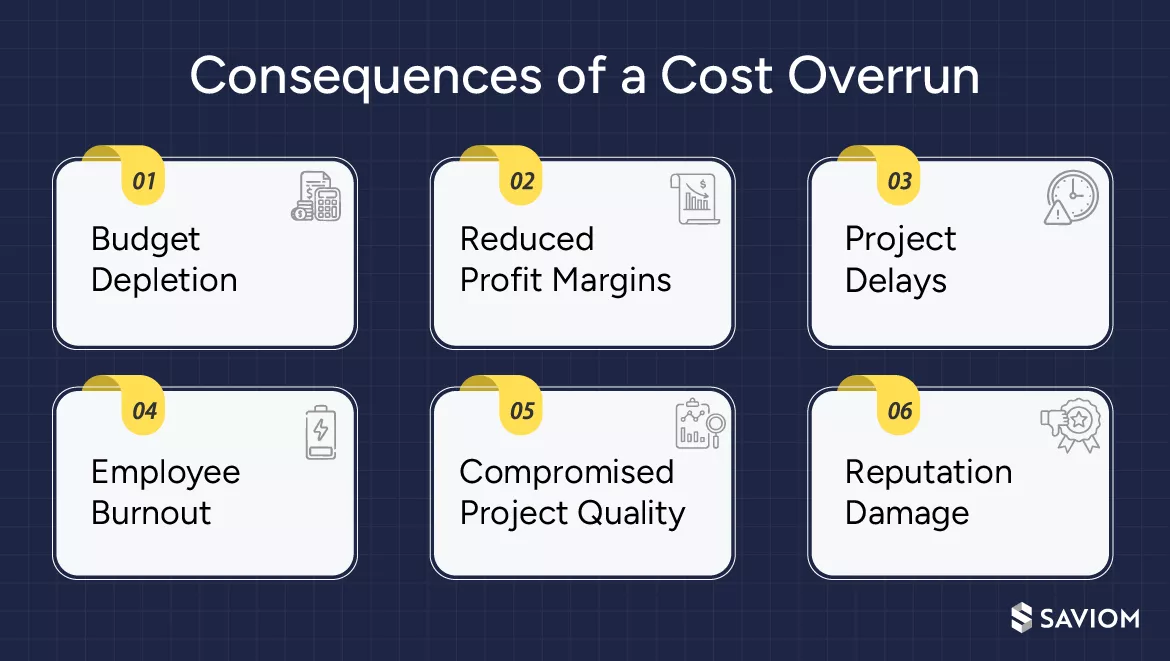
These are the consequences of a cost overrun in a project. Now, let’s learn a few tips to prevent this.
Tips to Prevent Cost Overruns in a Project
Here are a few tips that could help you prevent an overrun in your project:
Define the Project Scope Comprehensively
According to PMI, “37% of projects fail due to the lack of clear goals and vision.”
To avoid this, clearly define your project goal and scope from the start. The project scope is a structured outline that describes objectives, deliverables, and deadlines. Use the scope as a reference point to accurately estimate costs for each element and align expectations. Moreover, a scope document, which stakeholders approve, minimizes the risk of uncontrolled changes that increase time, effort, and cost.
Read More: What is a Project Scope? Benefits, Best Practices, and Steps to Create an Effective One
Conduct Thorough Project Planning
Plan the project thoroughly from the start to control overspending and prevent cost overrun. Use a work breakdown structure to divide the project into smaller tasks, subtasks, and work packages. This helps accurately estimate the time, resources, and costs required for each work package. Additionally, plan each phase to reduce the risk of missing critical elements and last-minute spending. It also supports smoother execution and tighter budget control.
Optimize Resource Allocation
Analyze the demand and availability of resources before assigning them to tasks. Allocate best-fit personnel based on their skillset, cost, and availability. Consider hiring from cost-effective locations to reduce overall project expenses. Moreover, proper resource allocation minimizes rework, improves productivity, and controls costs. Further, this directly helps in reducing unnecessary expenses and avoiding cost escalations.
Read More: What is Resource Allocation, and Why is it Important?
Evaluate the Pricing of Vendors
Before finalizing any vendor, thoroughly assess their pricing structure, service reliability, and past track records. Instead of focusing on a low quote, prefer vendor that offers consistent quality and comprehensive pricing. Additionally, ensure all costs are transparent to avoid hidden charges and mid-project budget surprises. A well-informed vendor choice can significantly reduce financial risks.
Keep Stakeholders Involved & Informed
Involve stakeholders from the beginning to align on goal, scope, and budget expectations. Their early input helps refine the scope, avoid rework, and catch feasibility issues before execution. It also reduces the risk of last-minute changes that inflate costs. Additionally, implement frequent feedback and update loops to keep them informed and avoid last-minute surprises. This proactive involvement keeps the project financially and strategically on track.
Develop a Realistic & Detailed Budget
Develop detailed budget that clearly maps out all project expenses, including potential risks. Implement a cost breakdown structure to accurately estimate costs for each work package. This ensures no component is overlooked and prevents cost underestimation. Use historical data, market rates, and expert input to make estimation accurate. Above all, set a realistic budget that accurately reflects project cost.
Read More: What is a Cost Breakdown Structure & How to Create One Effectively?
Establish a Change Management Process
Establish a formal change management process to evaluate and approve changes before they impact cost or timelines. It also prevents ad hoc decisions that can result in resource misalignment and budget slippage. Additionally, assess every change for its financial and operational impact. Gaining stakeholder approval ensures accountability and transparency. A structured approach keeps changes controlled and budgets intact.
Include Contingency Buffers in the Plan
Always include a contingency buffer to accommodate unforeseen expenses in the project. This serves as a safety cushion for unexpected expenses that may arise from a scope change, unplanned attrition, or a sudden increase in raw materials costs. Depending upon project type and complexity, build a buffer of 10-20% of the total budget to mitigate cost overruns and maintain project resilience.
Foster Open Communication with Team Members
Foster regular communication with team to identify problems before they become severe. Define communication lines such as daily stand-ups, emails, or meetings to receive updates from the team about progress, blockers, and resource needs. Additionally, share stakeholder updates promptly to prevent confusion and rework that leads to overspending. This two-way communication builds trust and boosts responsiveness which helps to avoid cost overrun.
Read More: What is Project Communication Management? Types, Benefits & Best Practices
Leverage the 80/20 Rule
The 80/20 rule says that 80% of outcomes come from just 20% of work. That’s why shift your focus to 20% of your work and deploy resources on high-impact tasks that move the needle. Avoid spreading efforts thin on low-impact work that drains productivity. Prioritizing critical tasks such as deliverables tied to milestones or financial outcomes avoids resource wastage, improves efficiency, and keeps the project on budget.
Utilize a Robust Cost Tracking Tool
One of the most effective ways to avoid a cost overrun is thorough real-time cost tracking. However, manual monitoring often leads to outdated data and errors. To prevent this, leverage a reliable cost-tracking tool to track every dollar spent. Cost tracking tools come with a visual dashboard, smart alerts, and automated reporting to highlight spending trends and flag potential slippage.
Conduct Regular Cost Tracking & Monitoring
Monitor project expenses consistently to stay aligned with the cost baseline. Regular tracking helps detect budget deviations early, allowing timely corrective action. It prevents small issues from turning into major cost overruns. Consistent monitoring keeps stakeholders informed about the project’s financial health and improves transparency across the board. Moreover, staying proactive with cost tracking ensures better budget control.
Read More: Understanding Cost Baseline in Project Management: Components, Benefits & Steps
Finally, explore how an advanced resource management tool can help prevent cost overruns.
How Can 5th Gen Resource Management Software Help Prevent Cost Overruns?
It is challenging to avoid cost overruns, but it is possible with the right tool and process. Here is how a 5th-generation resource management software can help managers keep the project under budget.
- The all-in-one resource planner allows project managers to filter resources by skill, experience, location, role, and cost rate. This helps them deploy resources from low-cost locations to prevent budget escalations.
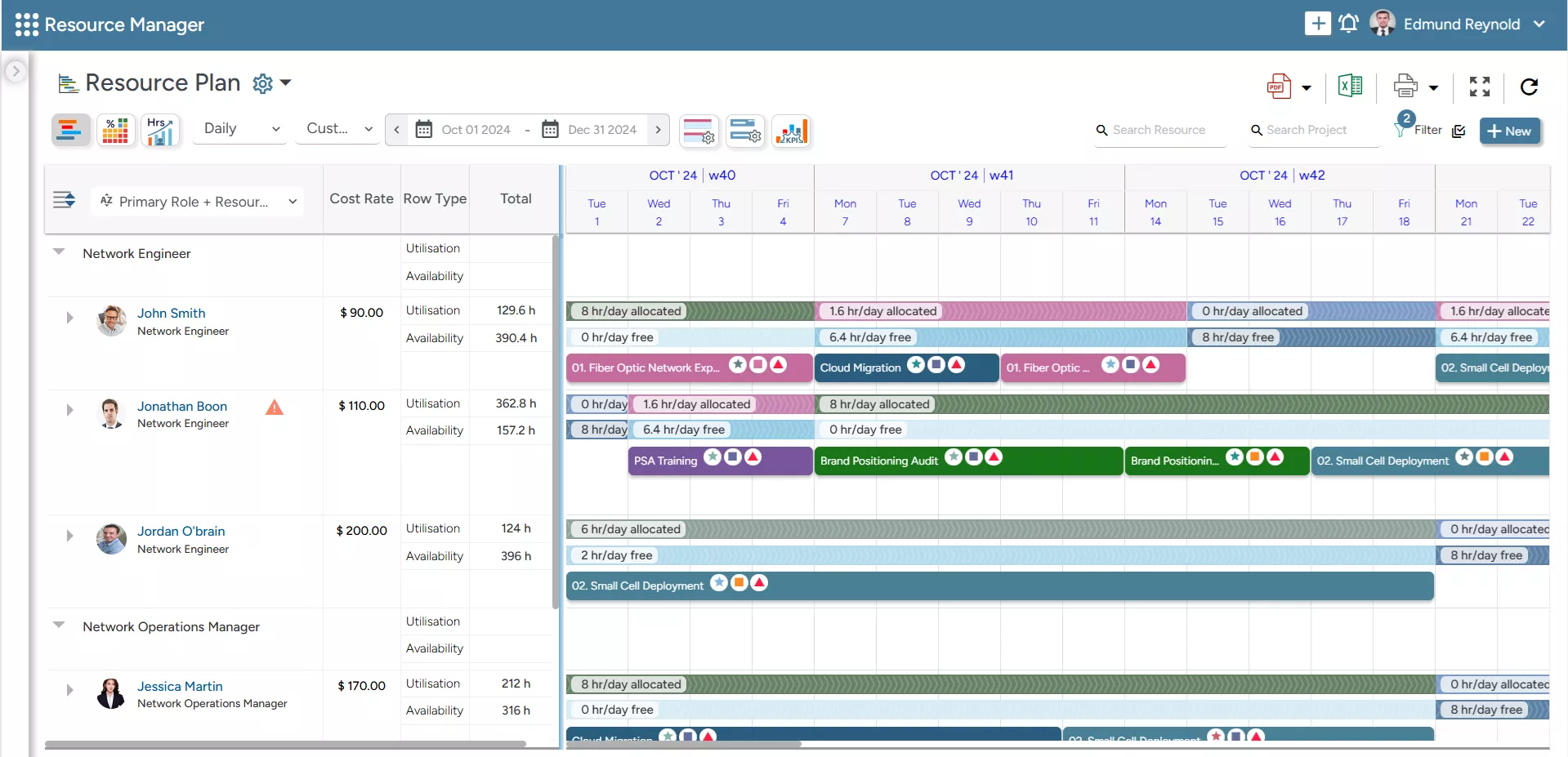
SAVIOM’s All-in-One Resource Planner provides 360-degree visibility of resources and projects, allowing managers to make informed decisions.
- Next, its embedded capacity planner provides flexibility to view resource capacity against demand and prevent last-minute costly hiring. Ultimately, this helps the manager avoid instances of cost overrun.
- Its intelligent match-making feature helps the manager assign the best-fit resource to the project based on skills, experience, and cost. This ensures that resources are competent enough to deliver high-quality work and are aligned with the project’s financial constraints.
- With the smart KPI forecaster, managers can track key resource metrics like utilization, availability, people on the bench, etc. This data allows them to prevent instances of underallocation or overstaffing, thereby avoiding financial slippage.
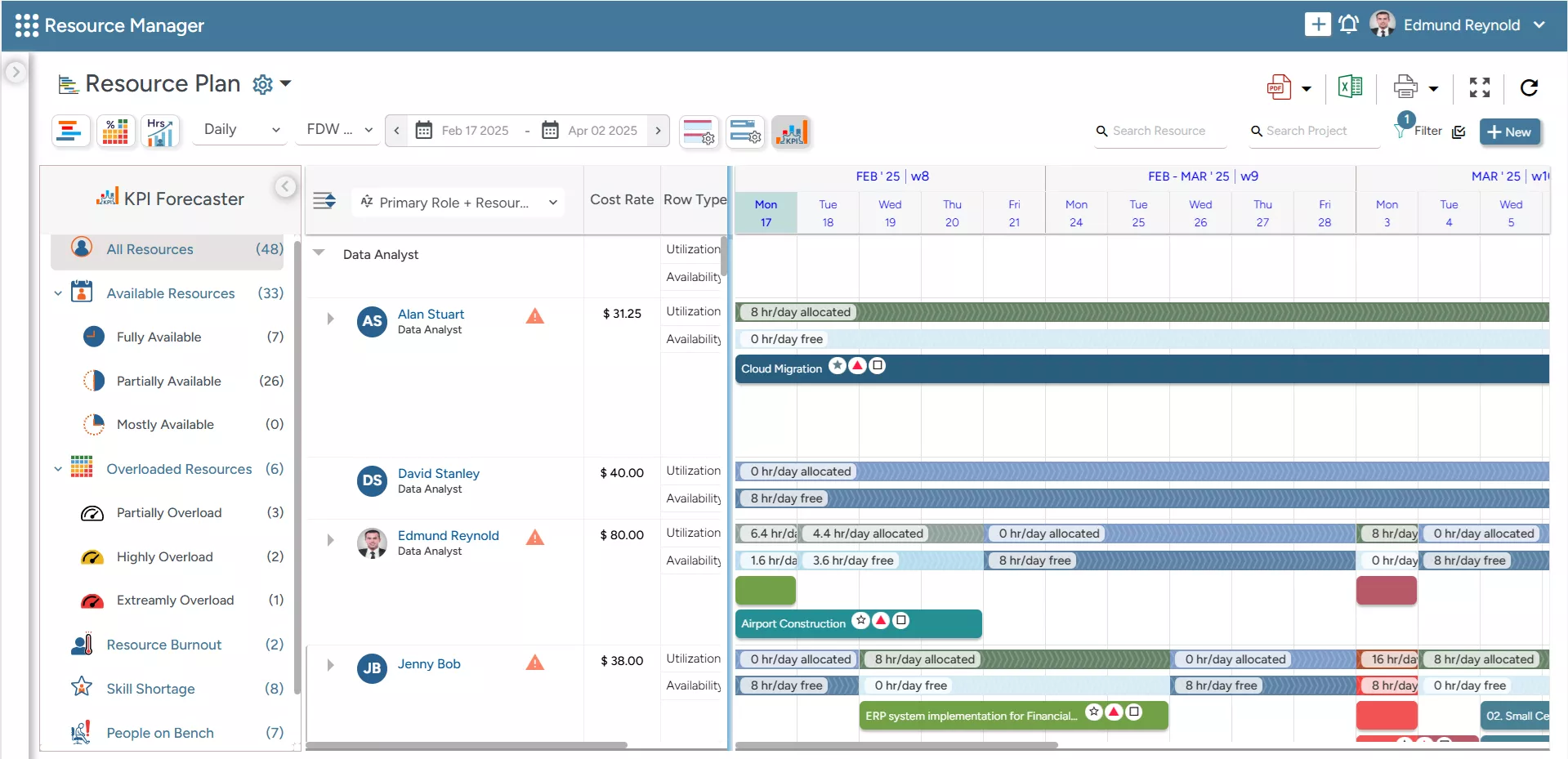
SAVIOM’s KPI forecaster enables managers to track key resource metrics like utilization, availability, people on bench, etc., in real-time.
2. The resource forecasting feature of the tool enables managers to anticipate future resource demands so that they can assess the cost required to cover them.
3. The real-time BI reports provide insights into the forecast vs. actual cost of the project. With its help, managers can monitor variances and take corrective actions beforehand.
4. The what-if analysis feature facilitates scenario-based resource optimization. It allows managers to create and compare various scenarios and arrive at the most profitable resource plan.
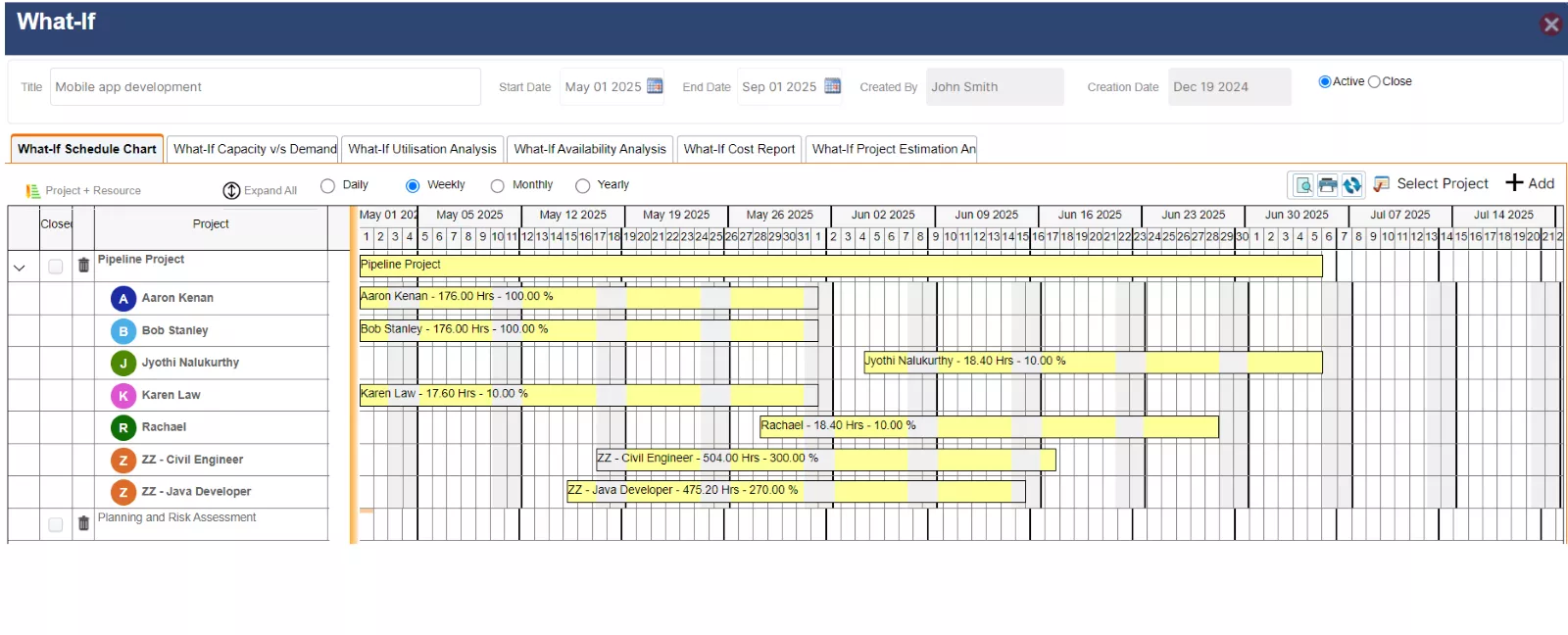
SAVIOM’s What-if Analysis feature empowers managers to simulate multiple scenarios to evaluate the potential impact of each scenario before selecting the most suitable plan.
Conclusion
In project management, avoiding cost is very difficult. No matter how carefully you plan, unexpected issues can still drive up your project costs. That’s why, rather than trying to avoid them entirely, the smarter approach is to prepare for them. With strong planning, clear communication, and the right tools, you can manage overruns effectively and reduce their impact.
So, how are you preventing cost overruns in your organization?
The Glossary
Read More: Glossary of Resource Workforce Planning, Scheduling and Management




